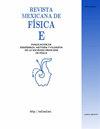一个Python程序,用于绘制能级图和计算量子缺陷,即高里德堡能级
Q4 Social Sciences
引用次数: 0
摘要
里德堡原子具有强大且可调节的原子相互作用,可以通过选择具有不同主量子数或轨道角动量的不同状态来调整。它们在量子信息应用中得到了广泛应用。此外,这些原子具有很长的寿命和许多可能的能级,它们的分离能够耦合到频率超过六个数量级的电磁场。我们研究了这些原子的一些性质,并开发了一个python程序;该程序提供了两个选项。首先,它计算了s、p、d和f轨道上元素的能量,并绘制了程序中列出的元素的能级图。其次,它提供了一个计算程序中列出或未列出的原子和离子的能量和量子缺陷的选项,并相应地生成它们的图。数据库中有21个元素可以绘制其能级图。可以通过添加更多元素来扩展数据库。本文章由计算机程序翻译,如有差异,请以英文原文为准。
A Python program to draw energy level diagram and to calculate quantum defects, the high lying Rydberg level
Rydberg atoms have strong and adjustable atomic interactions that can be tweaked by choosing different states with various principal quantum numbers or orbital angular momentum. They are highly used in quantum information applications. Furthermore, these atoms have long lifetimes and many possible energy levels, and their separations enable coupling to electromagnetic fields with frequencies ranging over six orders of magnitude. We studied some properties of these atoms and have developed a python program; the program gives two options. Firstly, it calculates energies of elements in s, p, d, and f orbitals and draws an energy level diagram of the element listed in the program. Secondly, it gives an option for calculating energy and quantum defects of atoms and ions, either listed or not listed in the program and generates their graphs accordingly. There are 21 elements in the database whose energy level diagrams could be drawn. The database can be extended by adding more elements.
求助全文
通过发布文献求助,成功后即可免费获取论文全文。
去求助
来源期刊

Revista Mexicana De Fisica E
社会科学-科学史与科学哲学
CiteScore
0.80
自引率
0.00%
发文量
14
审稿时长
>12 weeks
期刊介绍:
The Revista Mexicana de Física (Rev. Mex. Fis.) publishes original papers of interest to our readers from the physical science com unity. Language may be English or Spanish, however, given the nature of our readers, English is recommended. Articles are classified as follows:
Research. Articles reporting original results in physical science.
Instrumentation. Articles reporting original contributions on design and construction of scientific instruments. They should present new instruments and techniques oriented to physical science problems solutions. They must also report measurements performed with the described instrument.
Reviews. Critical surveys of specific physical science topics in which recent published information is analyzed and discussed. They should be accessible to physics graduate students and non specialists, and provide valuable bibliography to the specialist.
Comments. Short papers (four pages maximum) that assess critically papers by others authors previously published in the Revista Mexicana de Física. A comment should state clearly to which paper it refers.
 求助内容:
求助内容: 应助结果提醒方式:
应助结果提醒方式:


